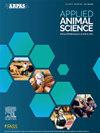Effects of initiating dietary narasin, at different production stages, on growth performance and carcass characteristics of growing-finishing pigs
IF 1.5
Q3 AGRICULTURE, DAIRY & ANIMAL SCIENCE
引用次数: 0
Abstract
Objective
Our objective was to determine the effects of initiating narasin, at different production stages, on growing-finishing pig performance.
Materials and Methods
In Exp. 1, 360 barrows (BW = 23.0 ± 0.13 kg) were used in a completely randomized design (45 pens; 15 replications) with 90-d treatments: (1) an unmedicated diet (CON), (2) 15 mg/kg narasin (NAR-90d), or (3) 11 mg/kg virginiamycin (VIR-90d). In Exp. 2, 480 barrows (BW = 26.3 ± 0.14 kg) were used in a completely randomized design (60 pens; 15 replications) with the following treatments: (1) unmedicated CON diet, (2) 15 mg/kg narasin (0 to 91 d; NAR-91d), (3) CON (0 to 56 d) followed by 15 mg/kg narasin fed from 56 to 91 d (NAR-35d), or (4) 27.6 mg/kg zinc bacitracin (0 to 91 d; ZB-91d). In Exp. 3, 416 barrows and gilts (BW = 84.3 ± 0.39 kg) were used in a randomized complete block design (52 pens; 26 replications) with 35-d treatments: (1) unmedicated CON diet or (2) NAR-35d.
Results and Discussion
In Exp. 1, pigs fed NAR-90d had greater BW (d 90) and ADG (d 0 to 90) compared with pigs fed the CON dietary treatment. The ADG of pigs fed NAR-90d were greater than those of pigs fed the CON treatment on d 0 to 28 and d 28 to 56 and VIR-90 on d 0 to 28. Pigs fed NAR-90d had greater hot carcass weights and yields than those fed CON or VIR-90d. In Exp. 2, pigs fed NAR-91d (d 0 to 56) and pigs fed NAR-35d (d 56 to 91) had greater ADG and ADFI than any of the other treatments. In Exp. 3, pigs fed NAR-35d had greater G:F than pigs fed the CON treatment.
Implications and Applications
Pigs fed narasin tended to have greater growth performance responses in the periods after first receiving narasin. However, when narasin is fed for the entire growing-finishing period, pigs may have carcass responses in some cases. Improvements in growth performance were realized whether narasin was initiated in the early grower or finishing phase.
不同生产阶段饲粮中添加纳拉西辛对生长肥育猪生长性能和胴体特性的影响
我们的目的是确定在不同生产阶段启动纳拉西辛对生长肥育猪生产性能的影响。材料与方法在实验1中,采用完全随机设计(45只;15个重复),90d处理:(1)无药饮食(CON), (2) 15 mg/kg维吉尼霉素(NAR-90d),或(3)11 mg/kg维吉尼霉素(VIR-90d)。在实验2中,采用完全随机设计(60头;15个重复),采用以下处理:(1)无药CON饮食,(2)纳拉西素15 mg/kg (0 ~ 91 d);(3) CON (0 ~ 56 d), 56 ~ 91d饲喂15 mg/kg纳拉辛(NAR-35d),或(4)27.6 mg/kg杆菌肽锌(0 ~ 91d;zb - 91 d)。在实验3中,416头母猪和后备母猪(体重= 84.3±0.39 kg)采用随机完全区组设计(52头;26个重复),35d处理:(1)无药CON饮食或(2)NAR-35d。结果与讨论在试验1中,饲粮饲喂NAR-90d的猪的体重(90d)和平均日增重(0 ~ 90d)高于饲粮饲喂CON的猪。饲喂NAR-90d的猪在第0 ~ 28天和第28 ~ 56天和第0 ~ 28天的平均日增重均高于饲喂CON的猪。饲粮NAR-90d的猪热胴体重和产量高于饲粮CON和VIR-90d的猪。在试验2中,饲喂NAR-91d (0 ~ 56 d)和饲喂NAR-35d (56 ~ 91d)的猪ADG和ADFI均高于其他任何处理。在实验3中,饲喂NAR-35d的猪的G:F大于CON处理的猪。意义和应用饲喂纳拉西辛的猪在第一次接受纳拉西辛后的一段时间内往往有更大的生长性能反应。然而,如果在整个生长-肥育期都饲喂那拉西辛,在某些情况下猪可能会有胴体反应。无论在生长期早期还是育肥期开始使用纳拉西辛,生长性能都得到了改善。
本文章由计算机程序翻译,如有差异,请以英文原文为准。
求助全文
约1分钟内获得全文
求助全文

 求助内容:
求助内容: 应助结果提醒方式:
应助结果提醒方式:


